Submitted:
05 January 2024
Posted:
08 January 2024
You are already at the latest version
Abstract
Keywords:
1. Introduction
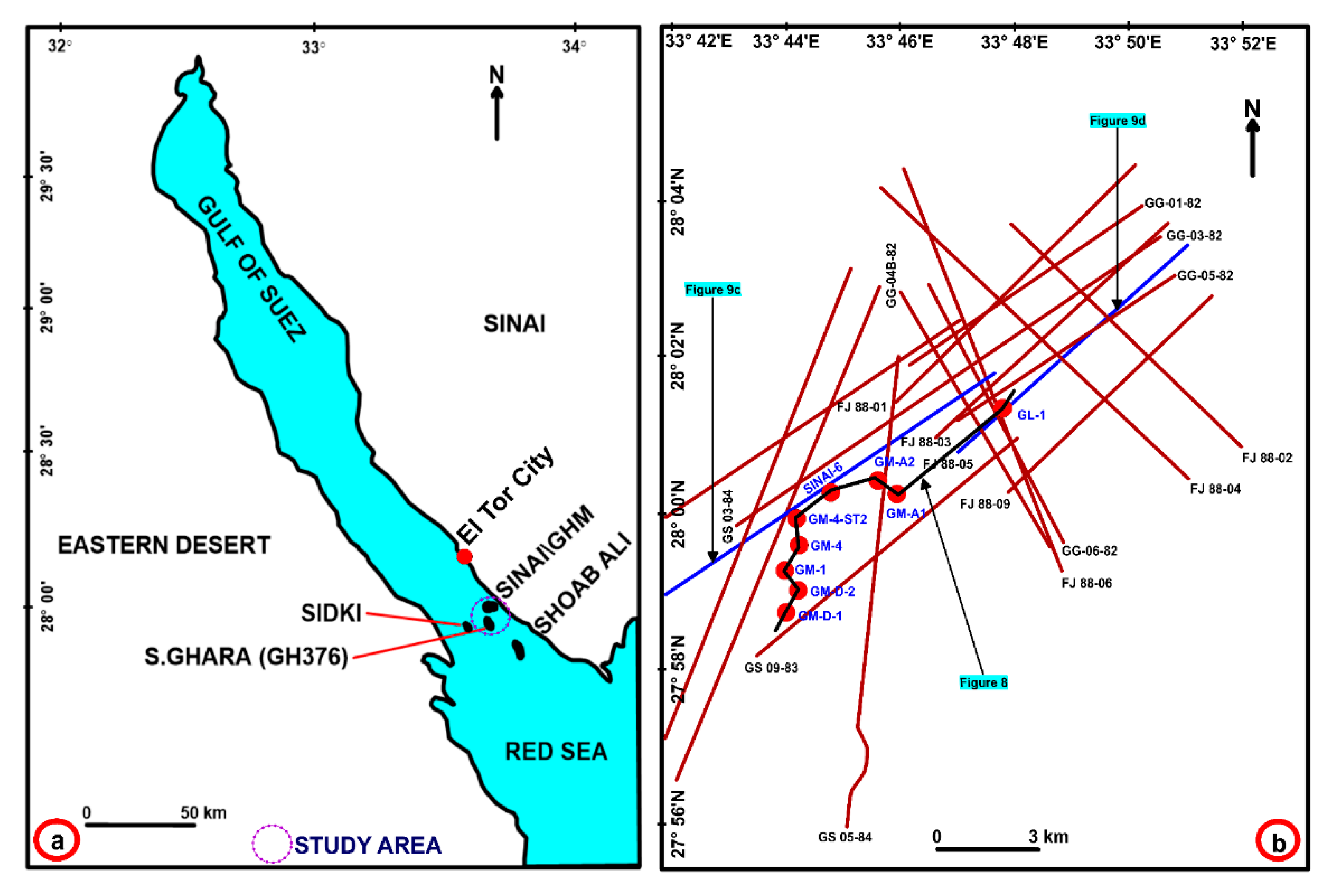
2. Tectonic and Stratigraphic Settings
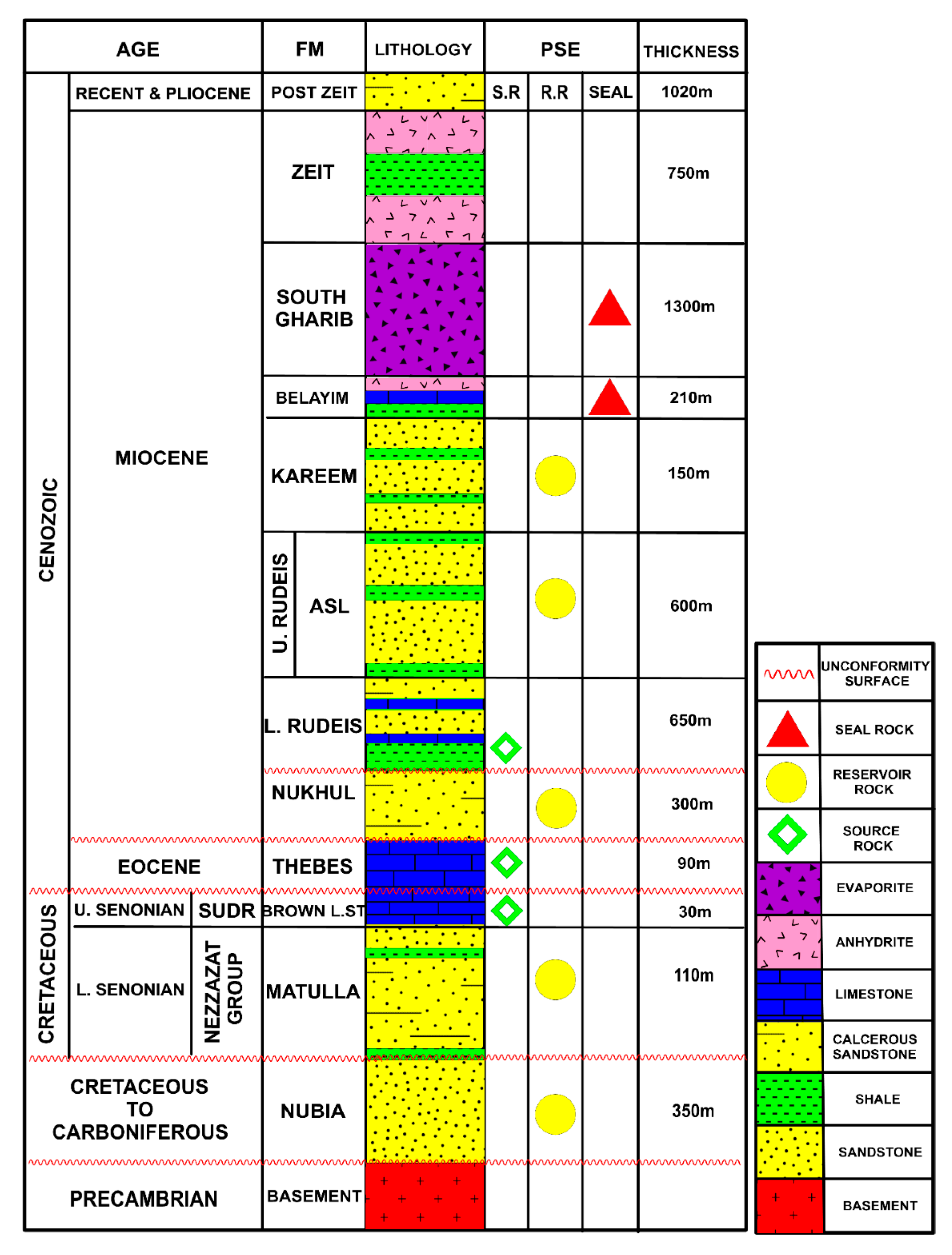
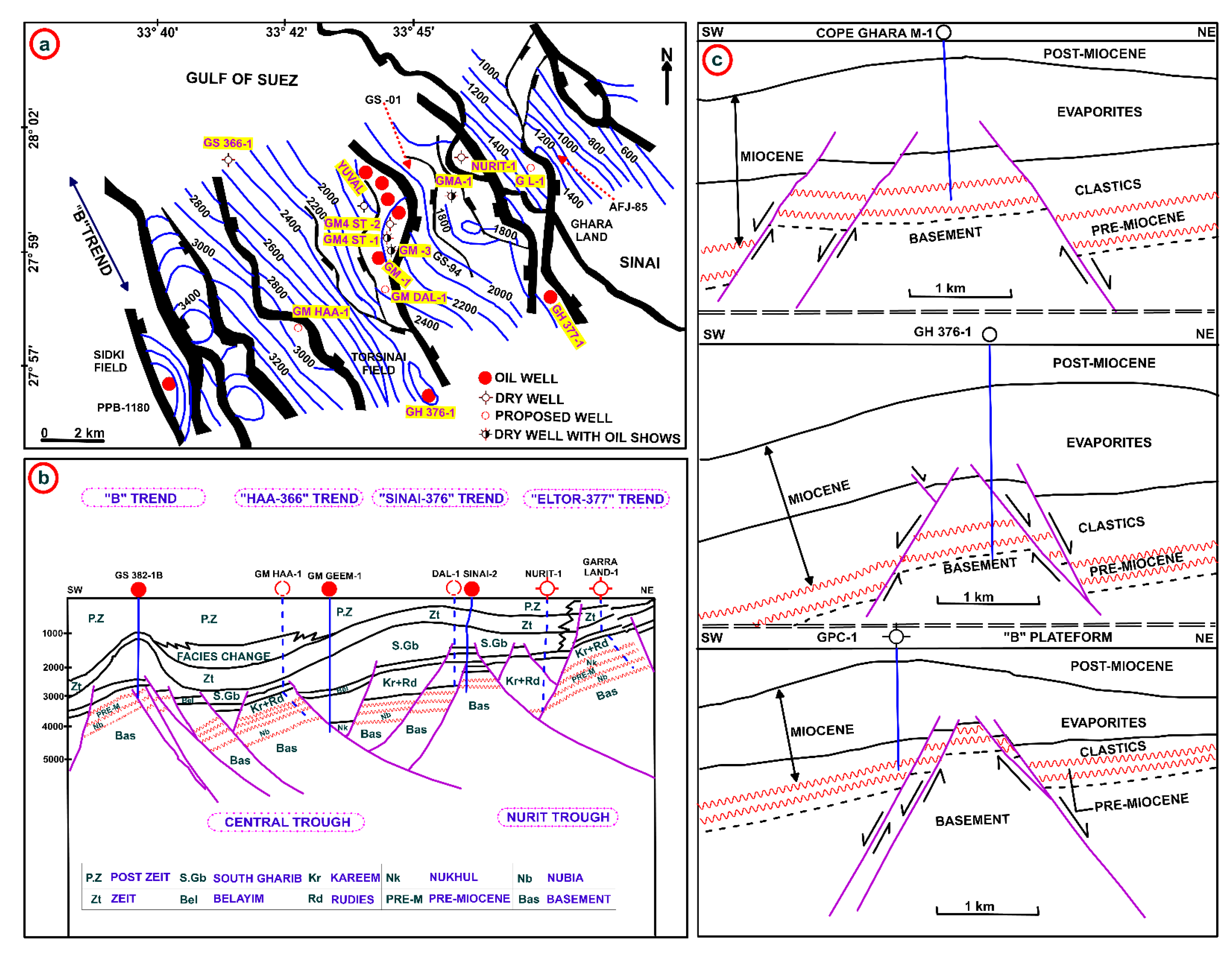
3. Data and Methods
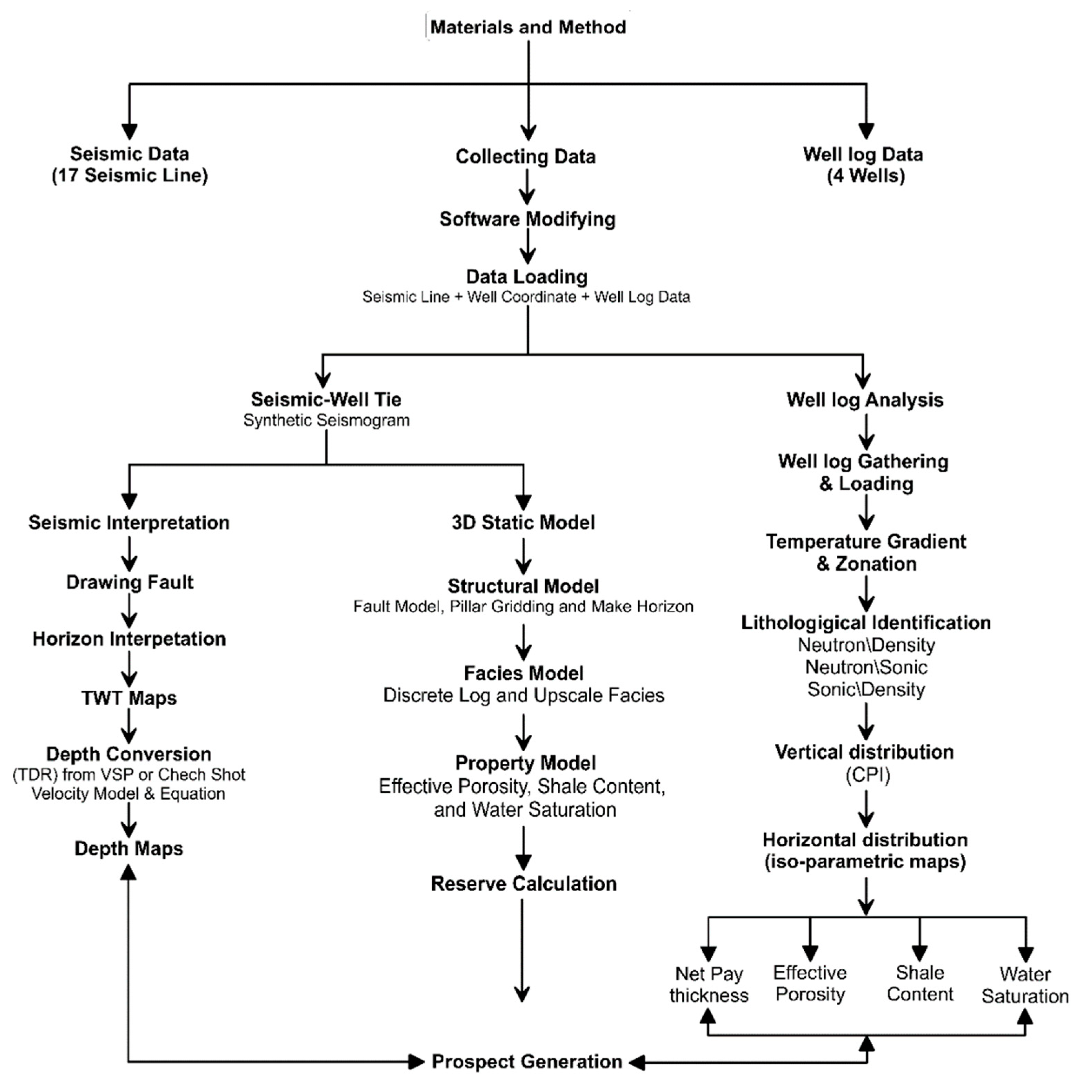
3.1. Petrophysical analysis
3.2. Seismic Data Interpretation
3.3. Three-dimensional static modeling
3.3.1. Structural Modeling
3.3.2. Stratigraphic Modeling
3.3.3. Property Modeling
4. Results and Discussion
4.1. Well-log analysis
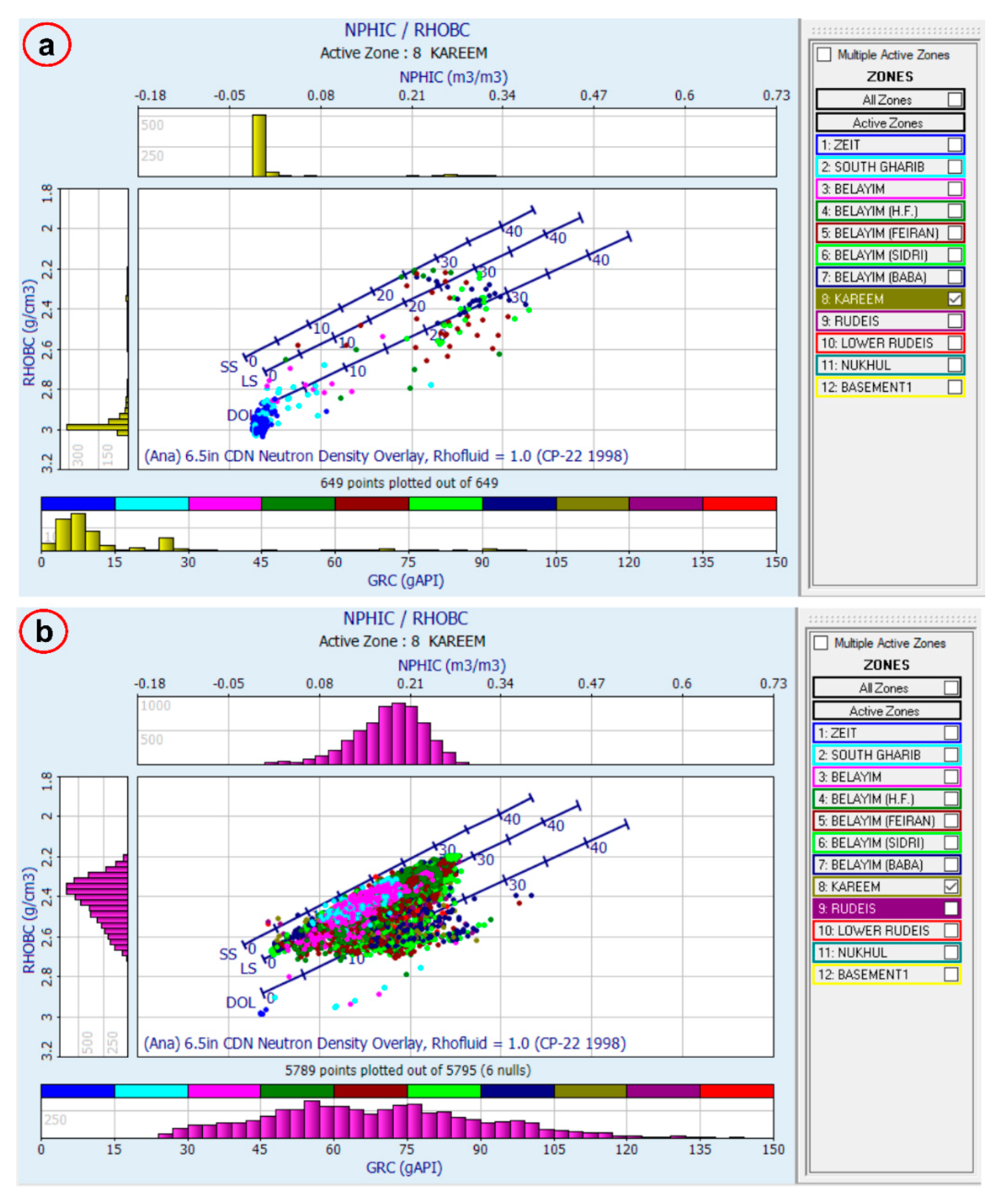
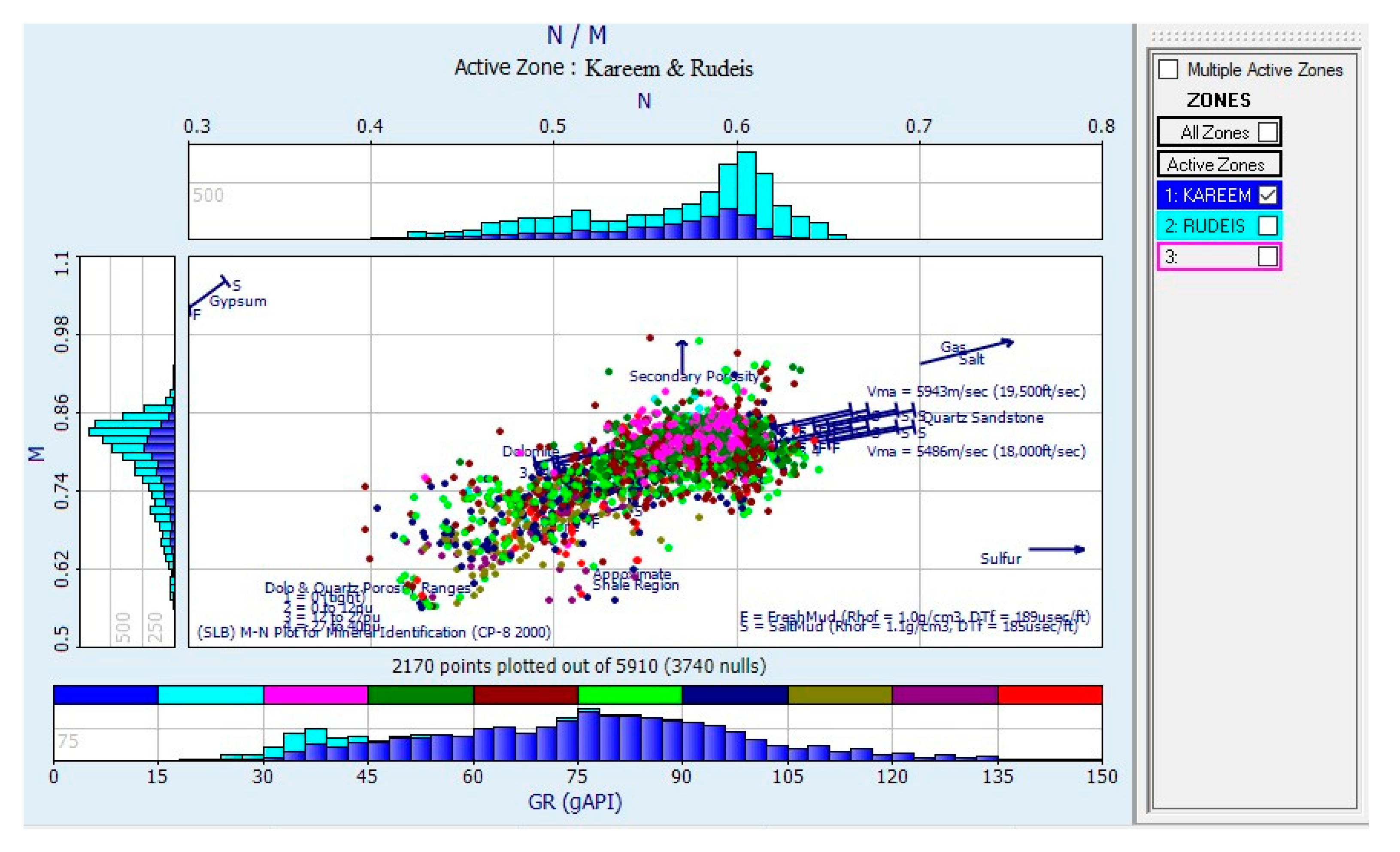
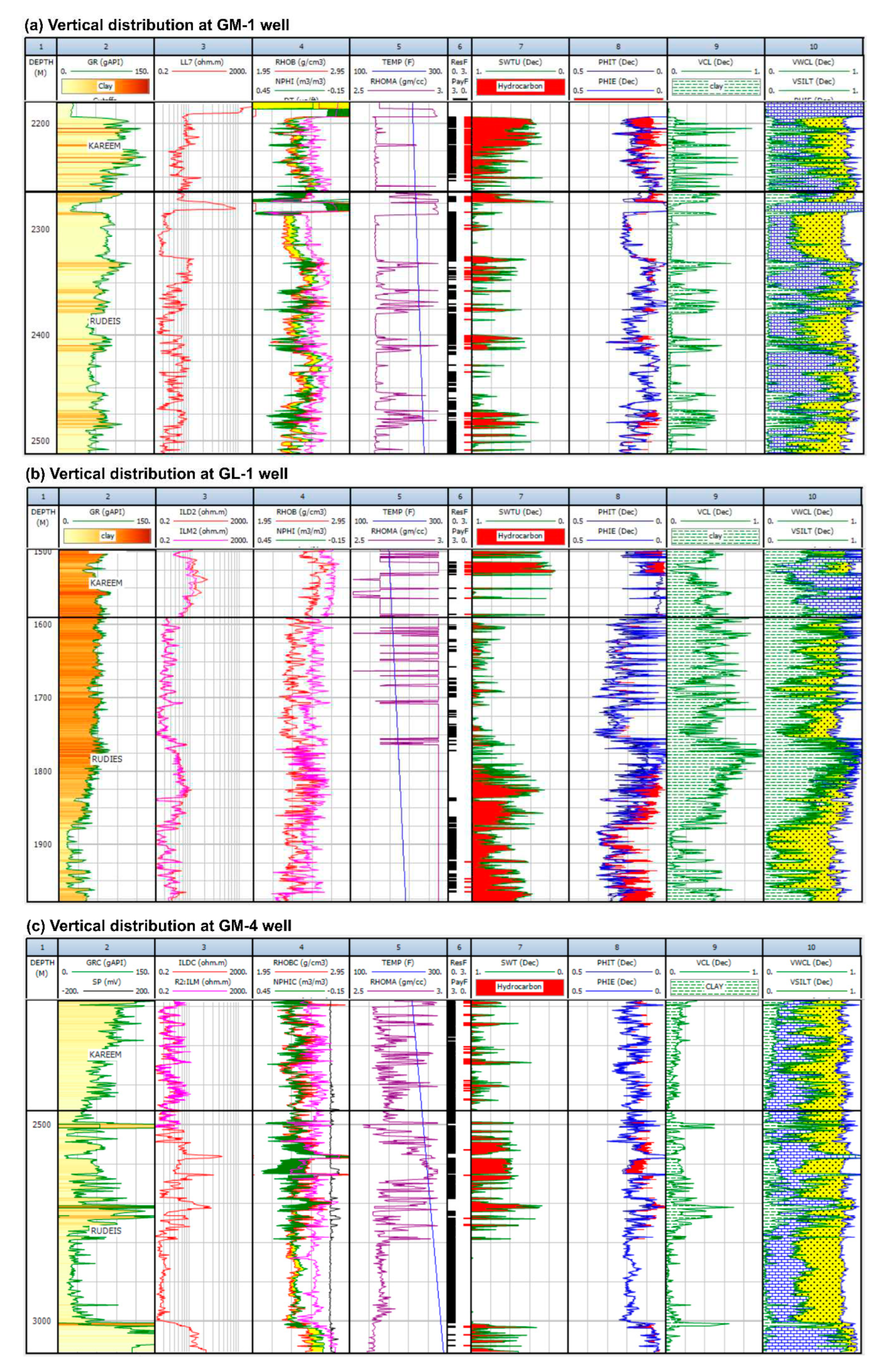
4.2. Stratigraphic Interpretation
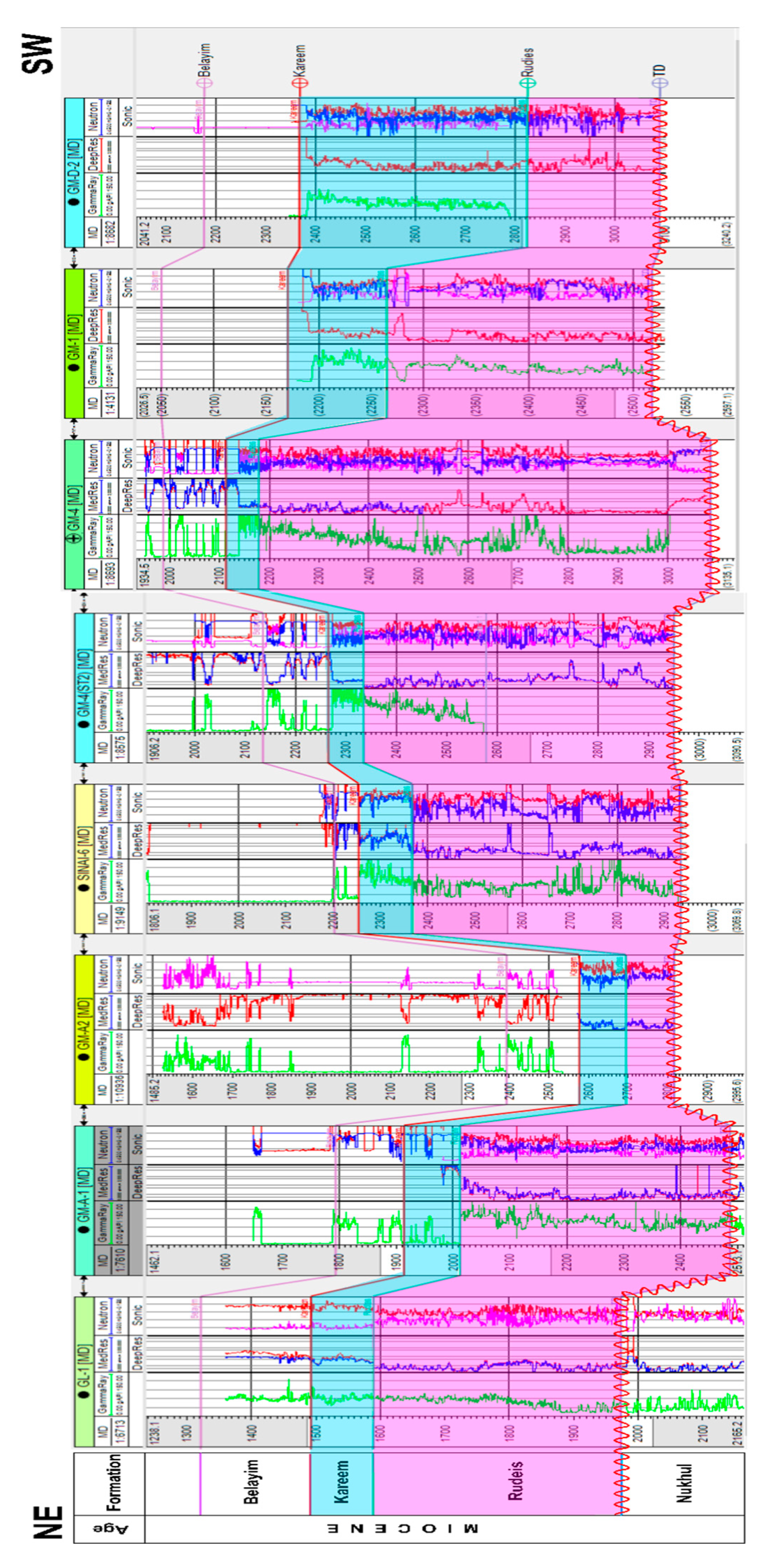
4.3. Structural Setting and Seismic Interpretation
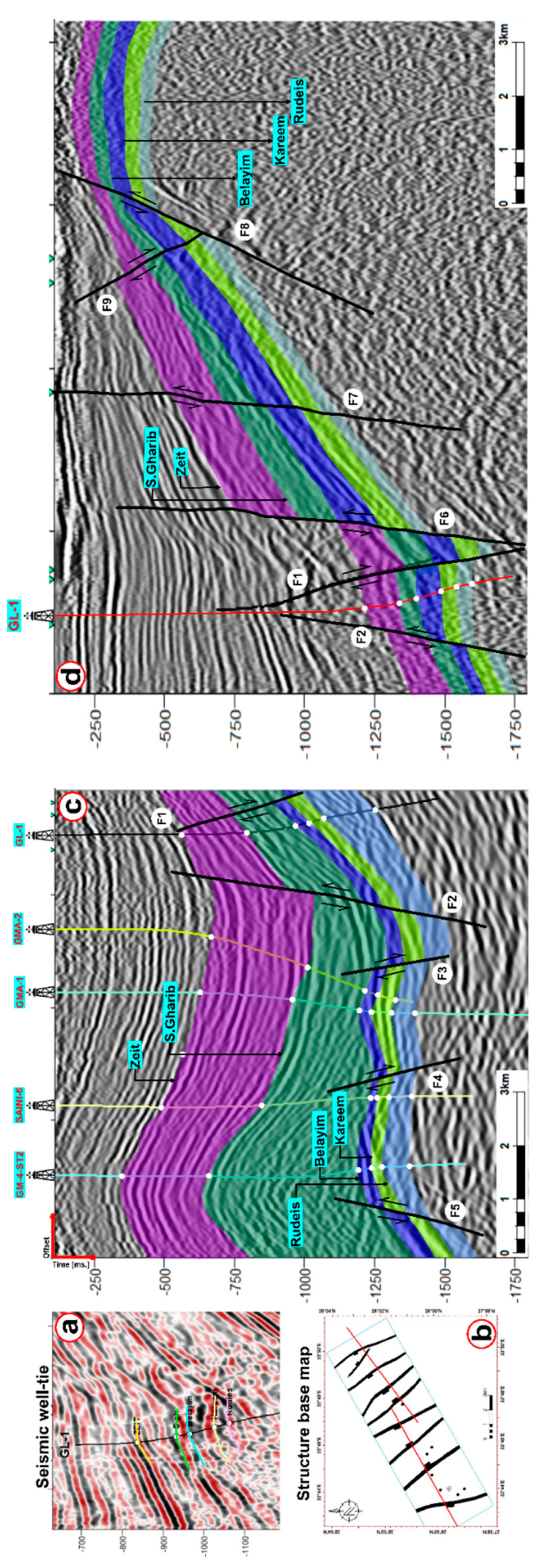
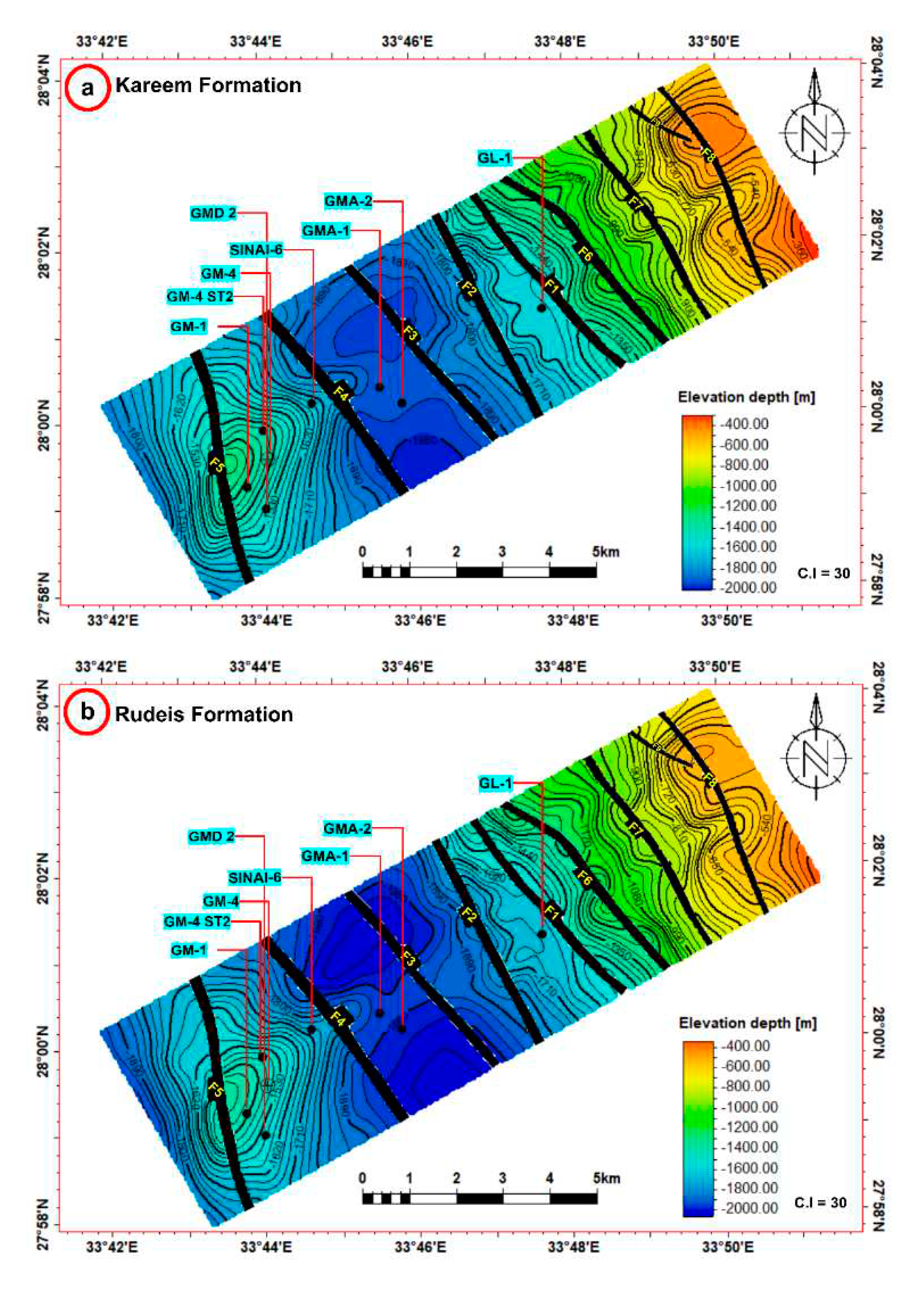
4.4. Three Dimentional Structural Model
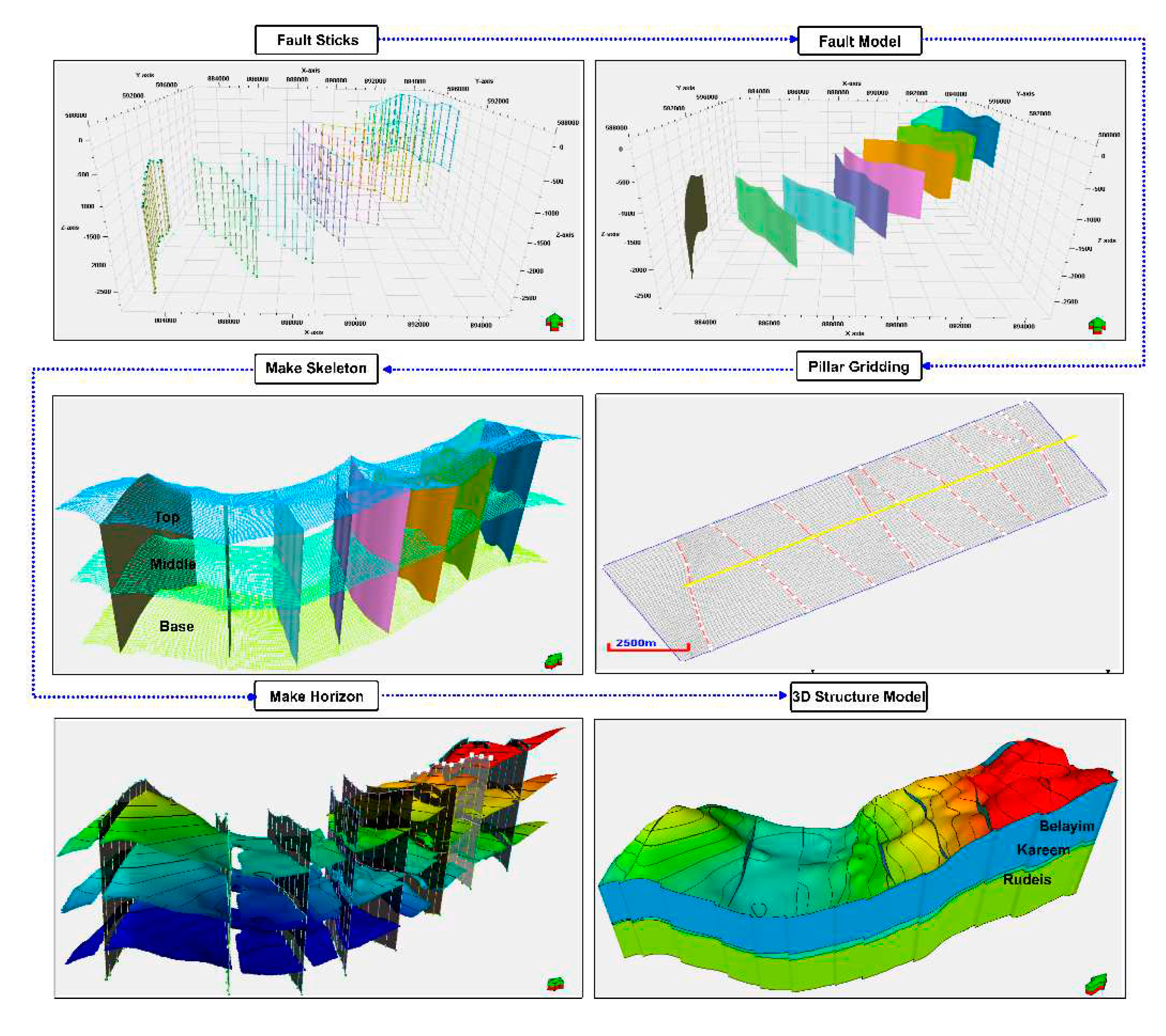
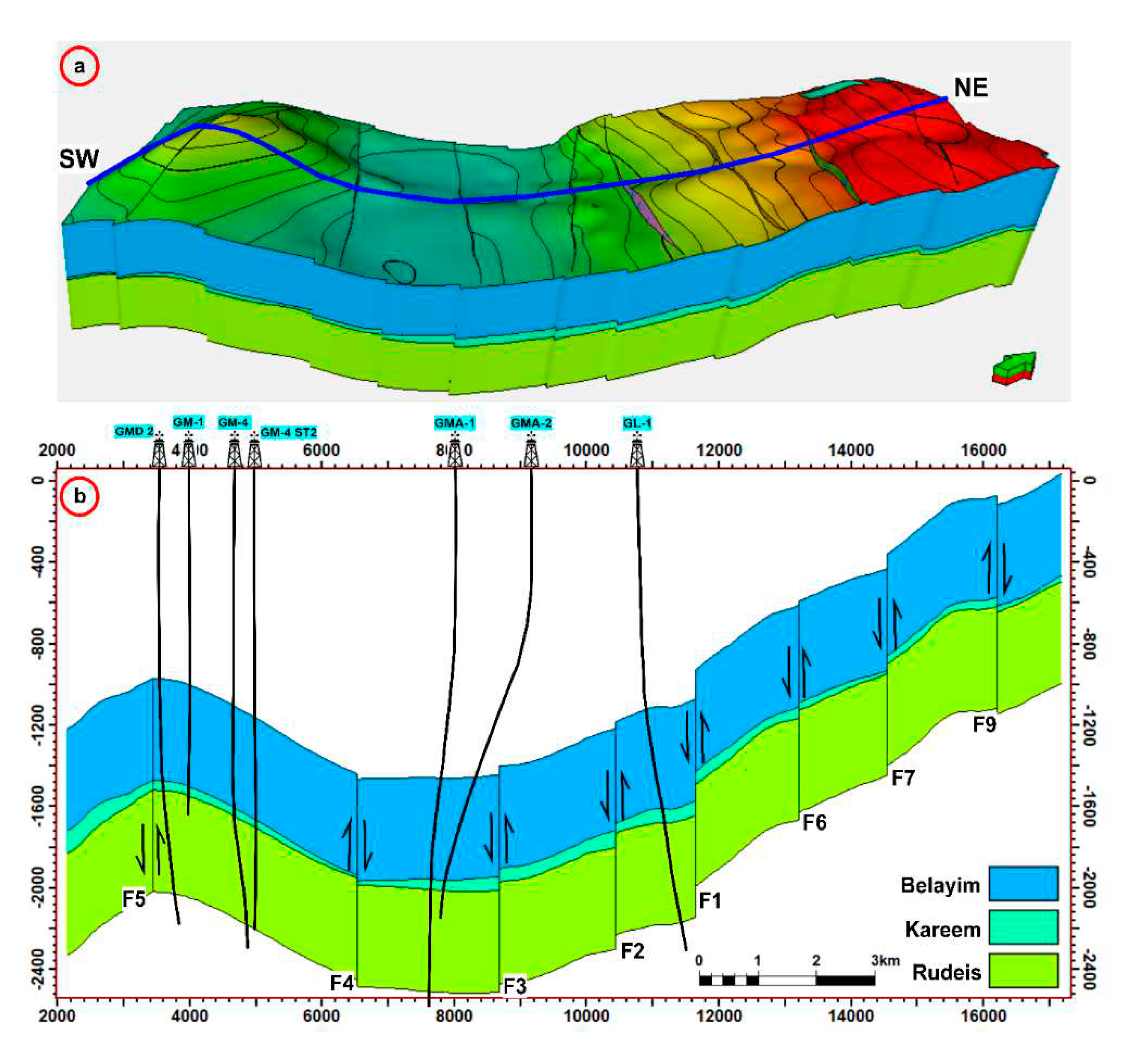
4.5. Three Dimentional Property Model
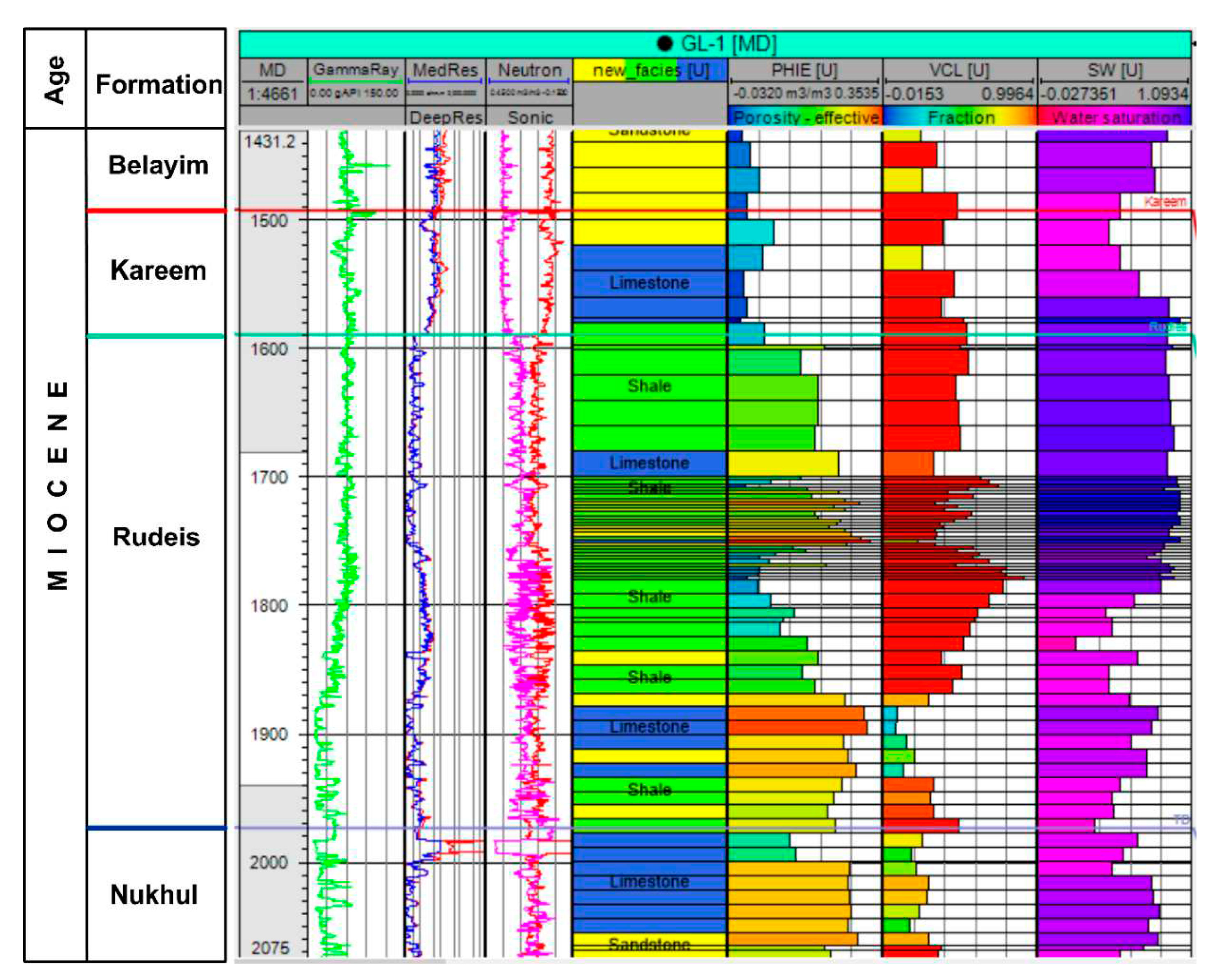
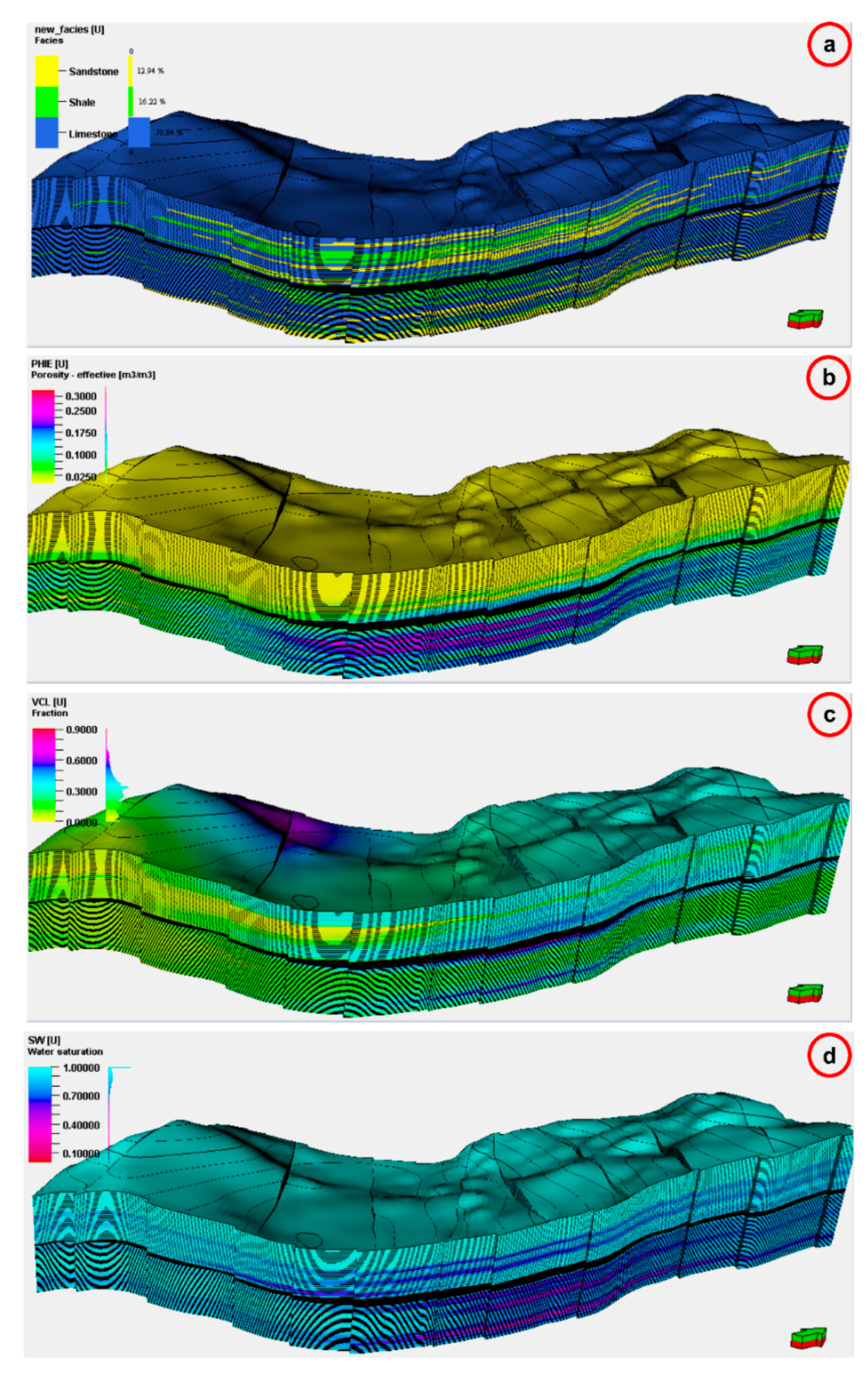
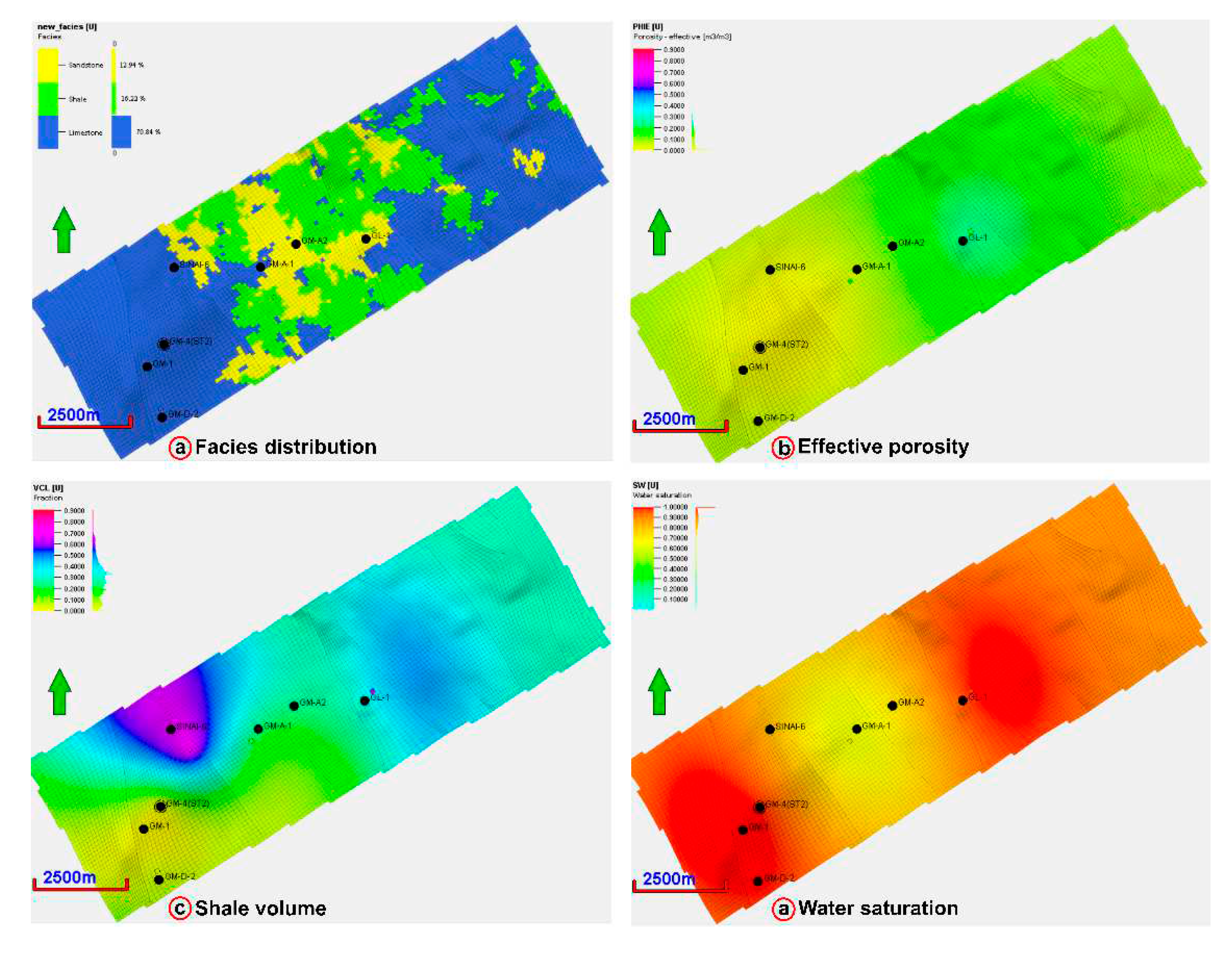
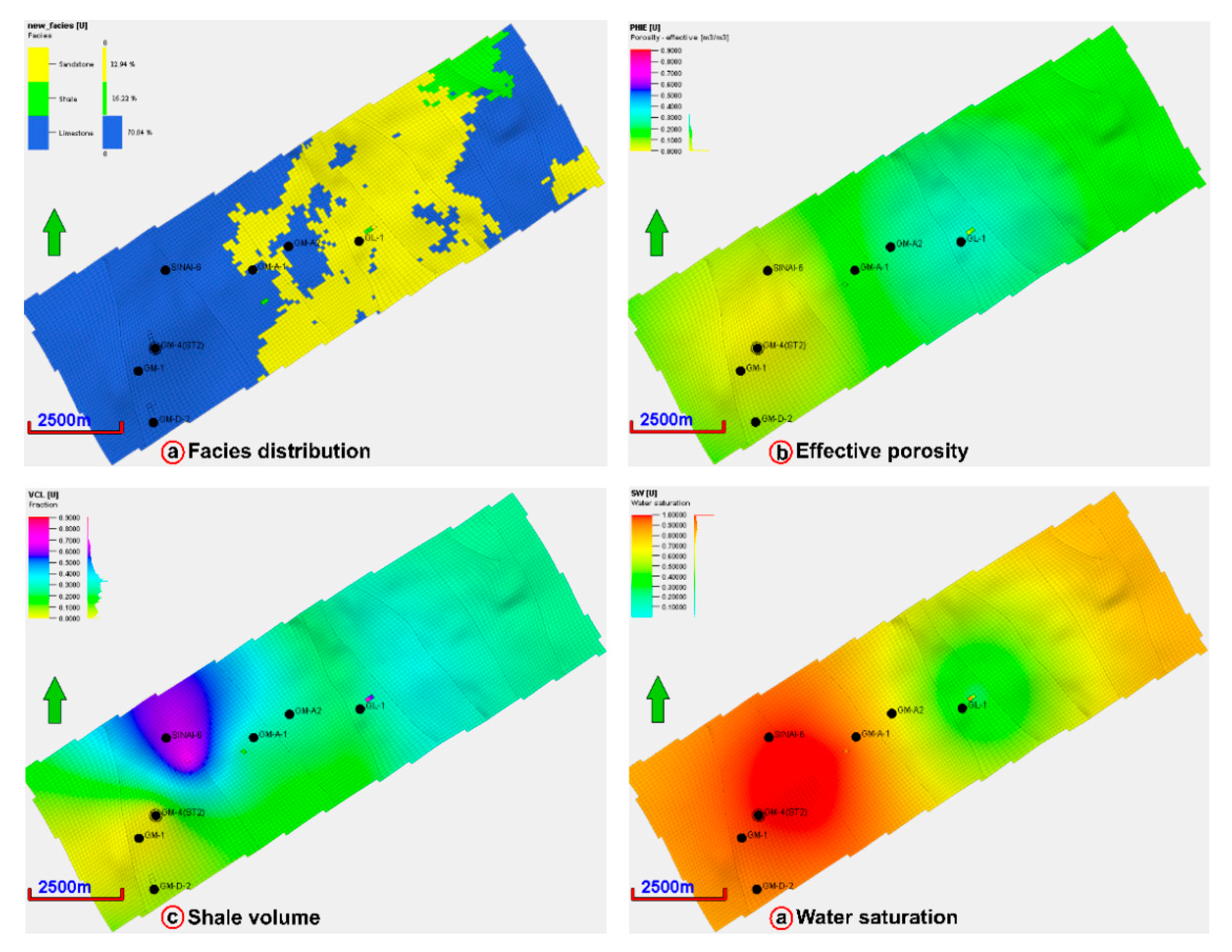
4.6. New Prospect and Reserve Estimation
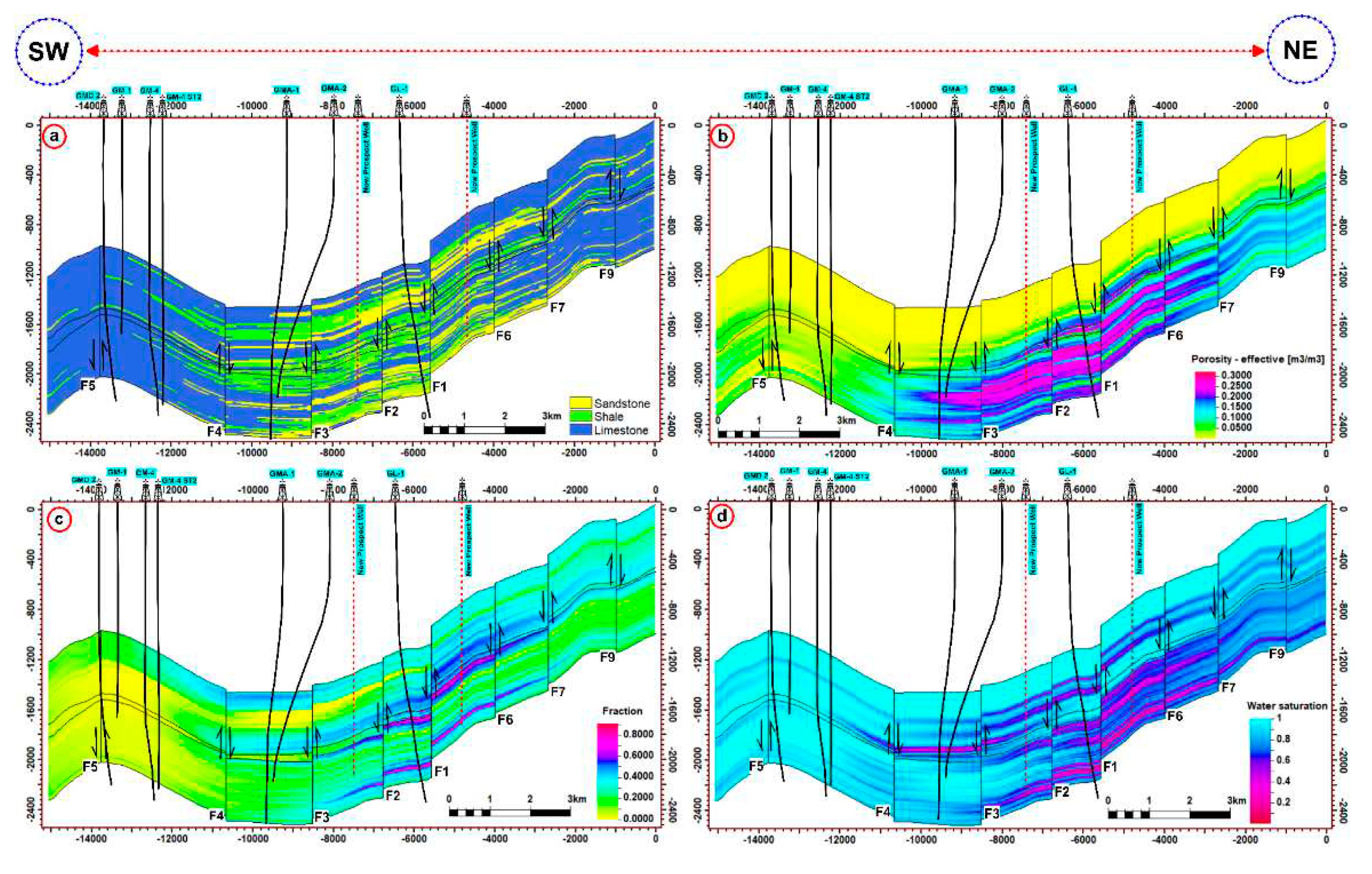
5. Coclusions
- This study presents an insightful understanding of the reservoir attributes of the Kareem and Rudeis formations. The petrophysical properties, lithology, faulted structures, and hydrocarbon distribution through a three-dimensional static model, has been established for Ras Ghara Field, southern Gulf of Suez.
- The established favorable hydrocarbon accumulations in fault horst blocks of Kareem and Rudies in Ras Ghara field are interpretable on 2D seismic reflection data despite structural imaging and seismic signal-to-noise issues.
- The petrophysical investigations determined that the net pay thicknesses varied between 3 m and 48 m in the Kareem reservoirs, and between 4 m and 58 m in the Rudeis reservoirs. The porosity range is 14–33% and 15–25%, respectively, while the hydrocarbon saturation range is 35–77% and 40–84%, respectively.
- The distribution pattern of the limestone and sandstone reservoir zone within the Ras Ghara oil field is primarily focused in the northeastern, southwestern, and central regions, displaying a discernible eastward migration from the Rudeis to Kareem formations. In essence, the central region stands out as the predominant location for the limestone and sandstone facies, distinguished by higher effective porosity and lower water saturation. This spatial arrangement of reservoir lithologies holds significant implications for high-impact journals, as it highlights the key areas of concentration and migration patterns of hydrocarbon-bearing formations in the Ras Ghara oil field.
- The estimated original oil in place (OOIP) within the reservoir formations of the Ras Ghara oil field indicates substantial quantities of oil, with the Kareem Formation holding 2,002,404 STB and 1,175,580 STB of oil for the proposed two new prospects, respectively. Additionally, the Rudeis Formation contains a noteworthy 6,302,916 STB and 2,841,894 STB, respectively.
Author Contributions
Funding
Data Availability Statement
Acknowledgments
Conflicts of Interest
References
- Guo, Y.; Yang, Y.; Wang, C. Global energy networks: Geographies of mergers and acquisitions of worldwide oil companies. Renew. Sust. Energ. Rev. 2021, 139, 110698. [Google Scholar] [CrossRef]
- Gawad, E.A.; Fathy, M.; Reda, M.; Ewida, H. Source rock evaluation of the Central Gulf of Suez, Egypt: A 1D basin modelling and petroleum system analysis. Geol. J 2021, 56(7), 3850–3867. [Google Scholar] [CrossRef]
- Lirong, D.O.U.; Zhixin, W.E.N.; Jianjun, W.A.N.G.; Zhaoming, W.A.N.G.; Zhengjun, H.E.; Xiaobing, L.I.U.; Zhang, N. Analysis of the world oil and gas exploration situation in 2021. Pet. Explor. Dev 2022, 49(5), 1195–1209. [Google Scholar] [CrossRef]
- Abd Elhady, M.A.; Fathy, M.; Hamed, T.; Reda, M. Petroleum evaluation through subsurface and petrophysical studies of Hammam Faraun Member of Belayim Formation, Bakr Oil Field, Gulf of Suez, Egypt. Nat Sci 2015, 13(4), 59-78. http://www.sciencepub.net/nature.10. /: 59-78. http.
- Gawad, E.A.; Fathy, M.; Reda, M.; Ewida, H. Petroleum geology: 3D reservoir modelling in the central Gulf of Suez, Egypt, to estimate the hydrocarbon possibility via petrophysical analysis and seismic data interpretation. Geol. J 2021, 56(10), 5329–5342. [Google Scholar] [CrossRef]
- Radwan, A.E. Three-dimensional gas property geological modeling and simulation. In Sustainable geoscience for natural gas subsurface systems, , David A. Wood, Jianchao Cai Wood, D.A., Cai, J; Gulf Professional Publishing: Oxford, United Kingdom, 2022; Volume 2, pp. 29-49). [CrossRef]
- 7. Reda, M.; Fathy, M.; Gawad, E.A. Comprehensive 3D reservoir modelling and basin analysis: An insight into petroleum geology, to reevaluate the hydrocarbon possibilities in the Siwa Basin, North Western Desert, Egypt. Geol. J 2022, 57(4), 1600–1616. [CrossRef]
- Mamdouh, M.; Reda, M.; Din, M.Z.E; Abdelhafeez, T.H. 3D petroleum reservoir modelling using seismic and well-log data to assess hydrocarbon potential in Abu Roash (G) Member, Karama Oil Field, North-Western Desert, Egypt. Geol. J 2023. 313-324. [CrossRef]
- Yilmaz, Ö. Seismic data analysis: Processing, inversion, and interpretation of seismic data, 2nd ed.; Society of exploration geophysicists, Tulsa, USA, 2001, 1238-1295. [CrossRef]
- Biondi, B.L. 3D seismic imaging, 1st ed.; Society of exploration geophysicists, Tulsa, USA., 2006, pp. 123–142. [CrossRef]
- Simm, R.; Bacon, M. Seismic Amplitude, 1st ed.; Cambridge University Press, Cambridge, UK, 2014; pp. 50-57.
- Sayers, C.M., 2013. Introduction: Rock physics for reservoir exploration, characterisation, and monitoring. Geophys. Prospect 2013, 61(2), 251-253. [CrossRef]
- Meshref, W.; Refai, E.M.; Abdel Baki, S.M., 1976. Structural interpretation of the Gulf of Suez and its oil potentialities. In Proceedings of the EGPC., 5th Petrol Explor. Semin.; Cairo, Egypt.
- Nakhla, A.M., 2005. An integrated seismotectonic- magnetotectonic study for the miocene-pre-miocene sequence in Abu Rudeis-Ras Budran area Gulf of Suez, Egypt, Ph.D. Banha University. June 15, 2005.
- Ghoneimi, A.; Azab, A.; Elsawy, M.; Alaa El-Din, A., 2020. Structural setup of Gara Marine area as deduced from 3D seismic interpretation and gravity-magnetic modelling, Gulf of Suez, Egypt. NRIAG J. Astron. Geophys 2020, 9(1), 483-490. [CrossRef]
- Fattouh, B.; and Darbouche, H. North African oil and foreign investment in changing market conditions. Energy Policy 2010, 38(2), 1119-1129. 2. [CrossRef]
- Dolson, J. C., M. Atta, D. Blanchard, A. Sehim, J. Villinski, T. Loutit and K. Romine, 2014, Egypt’s future petroleum resources: A revised look into the 21st century, in Petroleum systems of the Tethyan region: AAPG Memoir 106 L. Marlow, C. Kendall and L. Yose, eds., American Association of Petroleum Geologists, Tulsa, USA, 2014; p. 143–178. [CrossRef]
- Dolson, J., 2019. The petroleum geology of Egypt and history of exploration. In The Geology of Egypt. Regional Geology Reviews, Hamimi, Z., El-Barkooky, A., Martínez Frías, J., Fritz, H., Abd El-Rahman, Y. Eds; Springer, New York, USA. pp. (635-658. [CrossRef]
- Radwan, A.E.; Abdelghany, W.K.; Elkhawaga, M.A. Present-day in-situ stresses in Southern Gulf of Suez, Egypt: Insights for stress rotation in an extensional rift basin. J. Struct. Geol 2021, 147, 104334. [CrossRef]
- Esily, R.R.; Chi, Y.; Ibrahiem, D.M.; Amer, M.A. The potential role of Egypt as a natural gas supplier: A review. Energy Rep. 2022, 8, 6826-6836. [CrossRef]
- El-Qalamoshy, T.R.; Abdel-Fattah, M.I.; Reda, M.; et al. A multi-disciplinary approach for trap identification in the Southern Meleiha Area, North Western Desert, Egypt: integrating seismic, well log, and fault seal analysis. Geomech. Geophys. Geo-energ. Geo-resour. 2023, 9, 157. [Google Scholar] [CrossRef]
- Abdel-Gawad, M., 1970. A discussion on the structure and evolution of the Red Sea and the nature of the Red Sea, Gulf of Aden and Ethiopia rift junction-The Gulf of Suez: a brief review of stratigraphy and structure. Philosophical Transactions of the Royal Society of London. Series A, Mathematical and Physical Sciences, 267(1181), 41-48. [CrossRef]
- Evans, A.L., 1988. Neogene tectonic and stratigraphic events in the Gulf of Suez rift area, Egypt. Tectonophysics 1988, 153, 235–247. [CrossRef]
- Moustafa, A.R. Structural characteristics and tectonic evolution of the east-margin blocks of Suez rift. Tectonophysics 1993, 223, 223–381. [Google Scholar] [CrossRef]
- Schütz, K.I., 1994. Structure and stratigraphy of the Gulf of Suez, Egypt. In Interior rift basins, AAPG Memoir 59, Landon, S.M., Coury, A.B., Eds.; American Association of Petroleum Geologists, Tulsa, USA, pp. 57–96. [CrossRef]
- Bosworth, W.; McClay, K., 2001. Structural and stratigraphic evolution of the Gulf of Suez rift, Egypt: a synthesis. In Peri-Tethyan Memoir 6: Peri-Tethyan Rift/Wrench Basin and Passive Margins, Ziegler, P.A., Cavazza, W., Robertson, A.H.F., Crasquin-Soleau, S., Eds; Mémoires du Muséum national d'histoire naturelle, Paris, France, 567-606. https://personal.utdallas.edu/~rjstern/egypt/PDFs/Cenozoic%20Red%20Sea/Bosworth&McClay01.pdf.
- Moustafa, A.R.; and Khalil, S.M.. Structural setting and tectonic evolution of the Gulf of Suez, NW Red Sea and Gulf of Aqaba rift systems. The geol. of Egypt 2020, 295-342. [CrossRef]
- Abdine, A.S. Egypt's petroleum geology: Good grounds for optimism. World Oil 1981, 193, p. 7.
- Lelek, J.J.; Shepherd, D.B.; Stone, D.M.; Abdine, A.S., 1992. October Field: The Latest Giant under Development in Egypt's Gulf of Suez: Chapter 15. In M 54: Giant Oil and Gas Fields of the Decade 1978–1988, Halbouty, M.T., Ed.; American Association of Petroleum Geologists, Tulsa, USA, 1992; Volume 52, pp. 231–249. [CrossRef]
- Alsharhan, A.S.; Salah, M.G. Geology and hydrocarbon habitat in a rift setting: southern Gulf of Suez, Egypt. Bull. Can. Pet. Geol. 1994, 42, 312–331.
- Alsharhan, A.S.; Salah, M.G. Geology and hydrocarbon habitat in a rift setting: northern and central Gulf of Suez, Egypt. Bull. Can. Pet. Geol. 1995, 43, 156–176.
- EGPC, 1996. Gulf of Suez oil fields (a comprehensive overview); Egyptian General Petroleum Corporation: Cairo, Egypt, p. 736.
- Alsharhan, A.S., 2003. Petroleum geology and potential hydrocarbon plays in the Gulf of Suez rift basin, Egypt. Am Assoc Pet Geol Bull. 2003, 87, 143–180.
- Dolson, J. The Petroleum Geology of Egypt and History of Exploration. In The Geology of Egypt. Regional Geology Reviews; Hamimi, Z., El-Barkooky, A., Martínez Frías, J., Fritz, H., Abd El-Rahman, Y., Eds.; Springer: Cham, Switzerland. [CrossRef]
- McClay, K.R.; Nichols, G.J.; Khalil, S.M.; Darwish, M.; Bosworth, W. , 1998. Extensional tectonics and sedimentation, eastern Gulf of Suez, Egypt. In Sedimentation and tectonics of rift basins: Red Sea-Gulf of Aden, Purser, B.H., Bosence, D.W.J., Eds.; Springer, Dordrecht, Netherlands, 1998; pp. 223–238. [CrossRef]
- Young, M.J.; Gawthorpe, R.L.; Sharp, I.R. Sedimentology and sequence stratigraphy of a transfer zone coarse-grained fan delta, Miocene Suez Rift, Egypt. Sedimentology 2000, 47, 1081–1104. [CrossRef]
- Jackson, C.; Gawthorpe, R.; Carr, I.; Sharp, I. Normal faulting as a control on the stratigraphic development of shallow marine syn-rift sequences: the Nukhul and Lower Rudeis Formations, Hammam Faraun fault block, Suez Rift, Egypt. Sedimentology 2005, 52, 313–338. [CrossRef]
- El-Naby, A.I.M.; Ghanem, H.; Boukhary, M.; El-Aal, M.; Lüning, S.; Kuss, J. Sequence-stratigraphic interpretation of structurally controlled deposition: Middle Miocene Kareem Formation, southwestern Gulf of Suez, Egypt. Geoarabia 2010, 15, 129–150. [CrossRef]
- El-Khadragy, A.A.; Shazly, T.F.; Ramadan, M.; El-Sawy, M.Z. Petrophysical investigations at both Rudeis and Kareem formations, Ras Ghara oil field, Gulf of Suez, Egypt. Egypt. J. Pet. 2017, 26, 269–277. [CrossRef]
- El-Khadragy, A.A.; Shazly, T.F.; Mousa, D.A.; Ramadan, M.; El-Sawy, M.Z. Integration of well log analysis data with geochemical data to evaluate possible source rock. Case study from GM-ALEF-1 well, Ras Ghara oil Field, Gulf of Suez-Egypt. Egypt. Egypt. J. Pet. 2018, 27, 911–918. [CrossRef]
- Sakran, S.; Nabih, M.; Henaish, A.; Ziko, A. Structural regime and its impact on the mechanism and migration pathways of hydrocarbon seepage in the southern Gulf of Suez rift: An approach for finding new unexplored fault blocks. Mar Pet Geol. 2016, 71, 55-75.
- Hewaidy, A.G.A.; Mandur, M.M.; Farouk; S.; El Agroudy, I.S. Integrated planktonic stratigraphy and paleoenvironments of the Lower-Middle Miocene successions in the central and southern parts of the Gulf of Suez, Egypt. Arab. J. Geosci. 2016 , 9, pp.1-32.
- Sallam, E.S.; Afife, M.M.; Fares, M.; van Loon, A.J.; Ruban, D.A. Depositional cycles of the Lower Miocene Rudeis Formation (southwestern offshore margin of the Gulf of Suez, Egypt): Implications for reservoir evaluation. Mar. Geol. 2019, 415, 105964. [CrossRef]
- Farouk, S.; Sen, S.; Pigott, J.D.; Sarhan, M.A. Reservoir characterization of the middle Miocene Kareem sandstones, Southern Gulf of Suez Basin, Egypt. Geomech. Geophys. Geo-energ. Geo-resour. 2022, 8, 130. [CrossRef]
- Adelu, A.O.; Aderemi, A.A.; Akanji, A.O.; Sanuade, O.A.; Kaka, S.I.; Afolabi, O.; Olugbemiga, S.; Oke, R. Application of 3D static modeling for optimal reservoir characterization. J. African Earth 2019, 152, 184–196. [CrossRef]
- Ma, Y.Z.; La Pointe, P.R., (Eds.). Uncertainty analysis in reservoir characterization and management: how much should we know about what we don't know? In Uncertainty analysis and reservoir modeling: AAPG Memoir 96, Ma, Y.Z., La Pointe, P.R., eds.; American Association of Petroleum Geologists: Tulsa USA, 2011; pp. 1–15. Uncertainty analysis and reservoir modeling: AAPG Memoir 96, Ma, Y.Z., La Pointe, P.R., eds. pp. 1–15. [CrossRef]
- Yu, X.Y.; Ma, Y.Z.; Psaila, D.; Pointe, P.L.; Gomez, E.; Li, S., 2011. Reservoir characterization and modeling: a look back to see the way forward; In Uncertainty analysis and reservoir modeling: AAPG Memoir 96, Ma, Y.Z., La Pointe, P.R., eds.; American Association of Petroleum Geologists: Tulsa, USA, 2011; pp. 289–309. [CrossRef]
- .
- El-Bialy, M.Z.,. Precambrian Basement Complex of Egypt. In The Geology of Egypt. In The Geology of Egypt. Regional Geology Reviews, Hamimi, Z., El-Barkooky, A., Frías, J.M., Fritz, H., El-Rahman, Y.A., Eds.; Springer: Cham, Switzerland, 2020; pp. 37–79. [CrossRef]
- Salama, A.; El-Mougy, S.; El-Moneim, M.A.; Hakim, S. Exploration in Ras Ghara area, a case history, Southern Gulf of Suez, Egypt. Egypt J Pet Corp. 1994, 1, 240–257.
- El-Naby, A.A.; El-Aal, M.A.; Kuss, J.; Boukhary, M.; Lashin, A. Structural and basin evolution in Miocene time, south-western Gulf of Suez, Egypt. Neues Jahrbuch für Geologie und Paläontologie-Abhandlungen 2009, 251, 331–353. [CrossRef]
- Wanas, H.A. The Lower Paleozoic rock units in Egypt: An overview. Geosci Front 2011, 2, 492–507. [CrossRef]
- Tewfik, N.; Harwood, C.; Deighton, I., 1992. The Miocene, Rudeis, and Kareem Formations of the Gulf of Suez, Aspects of Sedimentology and Geohistory. In Proceedings of EGPC 11th Petroleum Exploration and Production Conference, Cairo, Egypt, 1992; 07/11/1992.
- Ayyad, H.M.; Hewaidy, A.G.A.; Omar, M.; Fathy, M., 2023a. Sequence stratigraphy and reservoir quality of the Gulf of Suez syn-rift deposits of the Nukhul formation: Implications of rift initiation and the impact of eustacy and tectonic on deposition. Mar Pet Geol. 2023, 156, 106459. [CrossRef]
- Ayyad, H.M.; Hewaidy, A.G.A.; Farouk, S.; Samir, A.; Bazeen, Y.S., 2023b. Sequence stratigraphy of the upper Oligocene–middle Miocene succession in west–central Sinai, Egypt. Geol. J. 2023, 58(1), 264-282. [CrossRef]
- Cannon, S. Reservoir modelling: A practical guide; John Wiley & Sons: New Jersy, USA, 2018; 47-156. [CrossRef]
- White, R.E.; Simm, R., 2003. Tutorial: Good practice in well ties. First break 2003, 21(10). 75-83.
- Khan, U.; Zhang, B.; Du, J.; Jiang, Z. 3D structural modeling integrated with seismic attribute and petrophysical evaluation for hydrocarbon prospecting at the Dhulian Oilfield, Pakistan. Front. Earth Sci. 2021, 15(3), 649-675. 3. [CrossRef]
- Zhang, B.; Tong, Y.; Du, J.; Hussain, S.; Jiang, Z.; Ali, S.; Khan, U. Three-dimensional structural modeling (3D SM) and joint geophysical characterization (JGC) of hydrocarbon reservoir. Minerals 2022, 12(3), 363. 3. [CrossRef]
- Tearpock, D.J.; Bischke, R.E.; Brenneke, J.; Metzner, D. Applied three-dimensional subsurface geological mapping: with structural methods, 3rd ed.; Pearson: Boston, USA; 2020, p. 992.
- Asquith, G.B., Krygowski, D. and Gibson, C.R., 2004. Basic well log analysis, 2nd ed.; American Association of Petroleum Geologists, Tulsa, USA, 2004; pp. 138-145.
- Boukhary, M.; Abd El Naby, A.; Faris, M.; Morsi, A. Plankton stratigraphy of the Early and Middle Miocene Kareem and Rudeis Formations in the central part of the Gulf of Suez, Egypt. Hist Biol. 2012, 24(1), 49-62. 1. [CrossRef]
- El Atfy, H.; Brocke, R.; Uhl, D.; Ghassal, B.; Stock, A.T.; Littke, R., 2014. Source rock potential and paleoenvironment of the Miocene Rudeis and Kareem formations, Gulf of Suez, Egypt: An integrated palynofacies and organic geochemical approach. Int J Coal Geol 2014, 131, 326-343. [CrossRef]
- .
- Alshangiti, A.; Zhou, H.W. Estimation of seismic attenuation for reservoirs mapping and inverse Q-filtering: An application on land seismic data. Geophys. Prospect 2023, 71(4), 682-697. 4. [CrossRef]
- Minshull, T.A.; Kearey, P.; Brooks, M., Hill, I. An Introduction to Geophysical Exploration, 3rd ed.; Blackwell Science, Oxford, UK, 2002; pp. 366-366. [CrossRef]
- Shepherd, M. Oil Field Production Geology, AAPG Memoir 91; The American Association of Petroleum Geologists, Tulsa, USA, 2009; p. 350. [CrossRef]
- Gluyas, J.G.; Swarbrick, R.E. Petroleum Geoscience, 2nd ed.; Wiley-Blackwell, Hoboken, USA, 2001; p. 432. https://books.google.com.eg/books?id=8uMXEAAAQBAJ.
- Hyne, N.J. Nontechnical Guide to Petroleum Geology, Exploration, Drilling, and Production, 3rd Ed.; Penn Well Corporation: Tulsa, Oklahoma, USA, 2001; p. 724.
Disclaimer/Publisher’s Note: The statements, opinions and data contained in all publications are solely those of the individual author(s) and contributor(s) and not of MDPI and/or the editor(s). MDPI and/or the editor(s) disclaim responsibility for any injury to people or property resulting from any ideas, methods, instructions or products referred to in the content. |
© 2024 by the authors. Licensee MDPI, Basel, Switzerland. This article is an open access article distributed under the terms and conditions of the Creative Commons Attribution (CC BY) license (http://creativecommons.org/licenses/by/4.0/).




